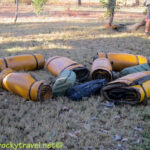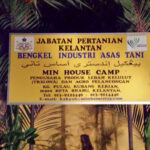Banh Cuon Cao Bang distinguishes itself from the Hanoi style primarily through its unique broth and fillings; SIXT.VN ensures you won’t miss out on tasting this difference when you visit Vietnam. While Hanoi’s version often features a light fish sauce, Cao Bang’s includes a savory bone broth, and their fillings, while both using pork, differ in preparation and added ingredients. Let’s explore these regional delicacies and unlock your dream Vietnamese vacation package with convenience.
1. Understanding Banh Cuon: A Vietnamese Culinary Delight
What exactly is Banh Cuon, and why is it so beloved in Vietnam?
Banh Cuon, also known as Vietnamese steamed rice rolls, is a popular breakfast and snack dish made from thin sheets of steamed rice flour. According to Vietnam National Authority of Tourism, Banh Cuon’s popularity stems from its delicate flavor and versatile nature, enjoyed plain or with various fillings. The dish is a testament to Vietnamese culinary ingenuity, showcasing simple ingredients transformed into a delightful culinary experience. Whether you’re a solo traveler, a couple, or a family, SIXT.VN can help you discover the best Banh Cuon spots in Vietnam.
2. Hanoi-Style Banh Cuon: A Classic Northern Taste
What makes Hanoi-style Banh Cuon unique?
Hanoi-style Banh Cuon typically features a delicate rice flour crepe filled with a mixture of ground pork and wood ear mushrooms. The dish is served with a light, flavorful fish sauce dipping sauce called “nuoc cham,” often accompanied by crispy fried shallots and Vietnamese ham (cha lua). The simple yet elegant combination of flavors and textures has made it a breakfast staple in Hanoi. According to Hanoi Tourism Department, many restaurants in Hanoi also offer options with egg, adding a richer flavor to the dish.
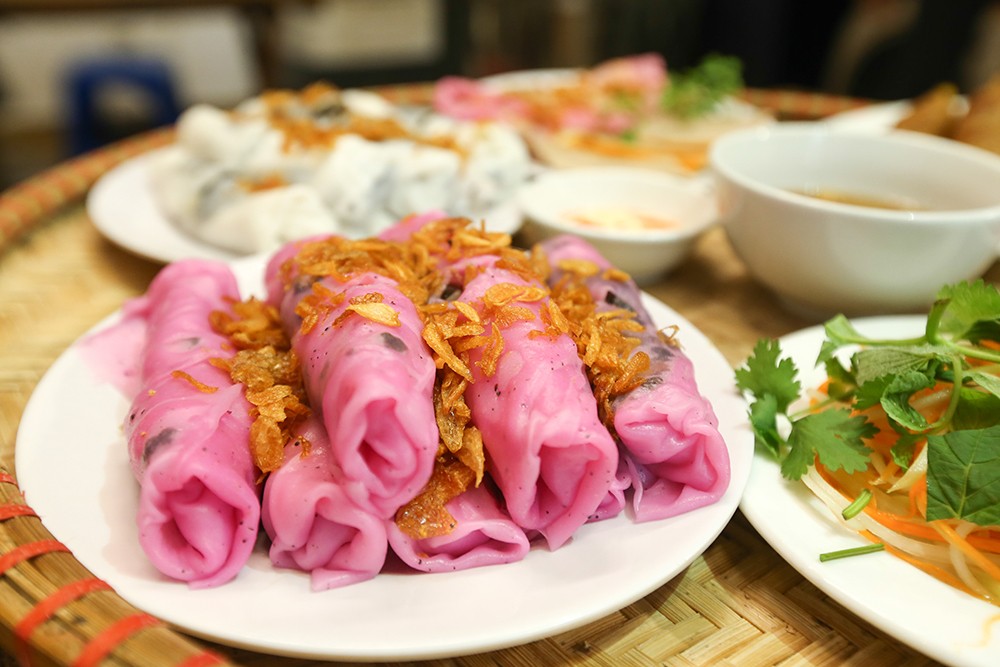 Hanoi Banh Cuon
Hanoi Banh Cuon
2.1. Key Characteristics of Hanoi-Style Banh Cuon
What are the defining traits of Hanoi-style Banh Cuon?
- Filling: Ground pork and wood ear mushrooms.
- Dipping Sauce: Light fish sauce (nuoc cham).
- Garnish: Crispy fried shallots, Vietnamese ham (cha lua).
- Texture: Thin, delicate rice flour crepe.
3. Cao Bang-Style Banh Cuon: A Mountainous Twist
How does Cao Bang-style Banh Cuon differ from the Hanoi version?
Cao Bang-style Banh Cuon stands out with its unique broth-based serving style and distinct filling. Instead of fish sauce, the steamed rice rolls are served in a warm, flavorful bone broth, often accompanied by Vietnamese pork sausage (gio cha), spring rolls, a sprinkle of herbs, pickled bamboo shoots and absolutely no crispy fried shallots. The filling consists of ground pork seasoned with spices but without wood ear mushrooms, offering a different taste profile compared to the Hanoi version.
3.1. Key Characteristics of Cao Bang-Style Banh Cuon
What are the defining traits of Cao Bang-style Banh Cuon?
- Filling: Ground pork seasoned with spices (no wood ear mushrooms).
- Broth: Warm, flavorful bone broth.
- Accompaniments: Vietnamese pork sausage (gio cha), spring rolls, herbs, pickled bamboo shoots.
- Texture: Slightly thicker rice flour crepe made from local rice varieties.
4. Banh Cuon: Preparation and Ingredients
What are the core elements of preparing Banh Cuon?
Preparing Banh Cuon, whether in Hanoi or Cao Bang, involves a few core elements: making the rice flour batter, steaming the crepes, preparing the fillings, and creating the accompanying sauce or broth. The process requires skill and precision to achieve the desired texture and flavor.
4.1. Rice Flour Batter: The Foundation
What is the composition of the rice flour batter?
The rice flour batter is the foundation of Banh Cuon, typically made from a mixture of rice flour, tapioca starch, and water. According to a study by the Institute of Food Technologists, the proportion of these ingredients affects the texture and elasticity of the crepe. The batter is mixed thoroughly to ensure a smooth, lump-free consistency.
4.2. Steaming the Crepes: A Delicate Art
How are the rice flour crepes steamed to perfection?
Steaming the crepes requires a specialized steamer covered with a thin cloth. A ladle of batter is spread thinly over the cloth, and the steamer is covered to allow the crepe to cook through. The cook uses a bamboo stick to carefully lift the delicate crepe from the cloth.
4.3. Fillings: Regional Variations
What are the typical fillings used in Banh Cuon?
The fillings for Banh Cuon vary by region. In Hanoi, the classic filling is a mixture of ground pork and wood ear mushrooms. In Cao Bang, the filling consists of seasoned ground pork without wood ear mushrooms. Some variations include shrimp, chicken, or vegetarian options.
4.4. Sauce and Broth: The Flavor Enhancers
What are the key ingredients in the sauce and broth?
The sauce and broth are essential components of Banh Cuon. Hanoi-style Banh Cuon is served with a light fish sauce (nuoc cham) made from fish sauce, water, sugar, lime juice, and chili. Cao Bang-style Banh Cuon is served with a warm bone broth simmered for hours with pork bones and spices.
5. Taste and Texture Comparison
How do Hanoi and Cao Bang Banh Cuon compare in terms of taste and texture?
The taste and texture of Hanoi and Cao Bang Banh Cuon offer distinct sensory experiences. Hanoi-style Banh Cuon boasts a delicate, savory flavor with a light, refreshing dipping sauce, while Cao Bang-style Banh Cuon features a richer, more robust flavor with a warm, comforting bone broth.
5.1. Hanoi-Style: Delicate and Savory
What is the taste profile of Hanoi-style Banh Cuon?
Hanoi-style Banh Cuon is characterized by its delicate and savory flavor. The thin rice flour crepe has a smooth, silky texture, while the ground pork and wood ear mushroom filling adds a subtle umami taste. The light fish sauce complements the dish with a balance of sweetness, sourness, and saltiness.
5.2. Cao Bang-Style: Rich and Robust
What is the taste profile of Cao Bang-style Banh Cuon?
Cao Bang-style Banh Cuon offers a richer, more robust flavor. The rice flour crepe is slightly thicker and chewier, while the seasoned ground pork filling adds a savory taste. The warm bone broth infuses the dish with a comforting depth of flavor, enhanced by the Vietnamese pork sausage, herbs, and pickled bamboo shoots.
6. Where to Find Authentic Banh Cuon
Where can you experience the best Banh Cuon in Hanoi and Cao Bang?
Finding authentic Banh Cuon in Hanoi and Cao Bang is part of the culinary adventure. In Hanoi, numerous street food stalls and restaurants serve the classic Hanoi-style Banh Cuon. In Cao Bang, local eateries and markets offer the unique Cao Bang-style Banh Cuon.
6.1. Hanoi’s Banh Cuon Hotspots
Which locations in Hanoi are known for their excellent Banh Cuon?
- Banh Cuon Ba Hanh: Known for its traditional Hanoi-style Banh Cuon with a generous filling and flavorful dipping sauce.
- Banh Cuon Gia An: Famous for its delicate crepes and fresh ingredients.
- Banh Cuon Thanh Van: Popular for its variety of Banh Cuon options, including egg and grilled meat.
6.2. Cao Bang’s Banh Cuon Gems
Where can you find the best Cao Bang-style Banh Cuon?
- Local Markets: Explore the local markets in Cao Bang to find vendors selling authentic Cao Bang-style Banh Cuon.
- Street Food Stalls: Look for street food stalls serving the unique Banh Cuon with bone broth and Vietnamese pork sausage.
- Specialty Restaurants: Some restaurants in Cao Bang specialize in serving traditional Banh Cuon with local ingredients.
7. Cultural Significance of Banh Cuon
What role does Banh Cuon play in Vietnamese culture?
Banh Cuon holds cultural significance in Vietnam as a popular breakfast and snack dish, reflecting the country’s culinary traditions and regional diversity. Banh Cuon is often enjoyed as a family meal, symbolizing togetherness and cultural heritage.
7.1. Banh Cuon as a Breakfast Staple
Why is Banh Cuon a popular breakfast choice in Vietnam?
Banh Cuon is a popular breakfast choice in Vietnam due to its light, nutritious, and flavorful qualities. The dish is easy to digest and provides a quick energy boost to start the day. According to a survey by the Vietnam National Institute of Nutrition, Banh Cuon is a preferred breakfast option among Vietnamese people of all ages.
7.2. Regional Variations as Culinary Heritage
How do regional variations of Banh Cuon contribute to Vietnam’s culinary heritage?
The regional variations of Banh Cuon, such as Hanoi-style and Cao Bang-style, contribute to Vietnam’s rich culinary heritage by showcasing the diversity of local ingredients and cooking techniques. Each variation reflects the unique cultural identity and culinary traditions of its respective region.
8. Nutritional Value of Banh Cuon
What are the nutritional benefits of eating Banh Cuon?
Banh Cuon offers several nutritional benefits, providing essential carbohydrates, protein, and vitamins. The rice flour crepe is a good source of energy, while the filling adds protein and other nutrients. However, the nutritional value of Banh Cuon can vary depending on the ingredients used.
8.1. Carbohydrates for Energy
How does Banh Cuon provide energy?
Banh Cuon is a good source of carbohydrates, which are the body’s primary source of energy. The rice flour crepe is easily digestible and provides a quick energy boost.
8.2. Protein for Muscle Building
How does Banh Cuon contribute to muscle building?
Banh Cuon contains protein from the filling, which is essential for muscle building and repair. The ground pork or shrimp in the filling provides amino acids necessary for protein synthesis.
8.3. Vitamins and Minerals
What vitamins and minerals can you find in Banh Cuon?
Banh Cuon can provide various vitamins and minerals depending on the ingredients used. The wood ear mushrooms in the Hanoi-style filling are a good source of iron and vitamin D. The herbs and vegetables served with Banh Cuon can provide vitamins A and C.
9. Making Banh Cuon at Home: A Recipe Guide
Can you make Banh Cuon at home?
Making Banh Cuon at home is a rewarding culinary experience, allowing you to customize the dish to your preferences. Here’s a simplified recipe guide to help you create your own Banh Cuon:
9.1. Ingredients
What ingredients do you need to make Banh Cuon?
- 1 cup rice flour
- 1/2 cup tapioca starch
- 2 cups water
- 1/2 lb ground pork
- 1/4 cup wood ear mushrooms, soaked and chopped
- Fish sauce, sugar, lime juice, chili (for dipping sauce)
- Crispy fried shallots (for garnish)
9.2. Instructions
What are the steps to making Banh Cuon at home?
- Mix rice flour, tapioca starch, and water to make the batter.
- Cook ground pork with chopped wood ear mushrooms.
- Steam the rice flour crepes on a specialized steamer.
- Fill each crepe with the pork mixture.
- Serve with fish sauce dipping sauce and crispy fried shallots.
10. Banh Cuon Around Vietnam: Other Regional Variations
Are there other regional variations of Banh Cuon in Vietnam?
Besides Hanoi and Cao Bang, other regions in Vietnam offer unique variations of Banh Cuon, each with its distinct flavors and ingredients.
10.1. Thanh Tri Steamed Rice Roll (Hanoi)
What makes Thanh Tri Steamed Rice Roll special?
In Hanoi, there is also Thanh Tri steamed rice roll with very own characteristics. Traditional Thanh Tri steamed rice roll are usually thinly coated, so the cake is clear and has a certain plasticity, the inside will not have a filling and is sprinkled with a lot of fried onions on top. Served with Thanh Tristeamed rice roll is “cha”, of course an indispensable a cup of dipping sauce made from fish sauce, sticky vinegar and a few slices of fresh chili. Currently, some shops also serve more Vietnamese steamed rice rolls with minced wood ear, egg filling and grilled meat to increase the attractiveness.
 Hanoi Banh Cuon
Hanoi Banh Cuon
10.2. Phu Ly Roll Cake (Ha Nam)
What is unique about Phu Ly Roll Cake?
If Hanoi has the famous Thanh Tri rolls, Ha Nam is also famous near and far with Phu Ly rolls. This Vietnamese version of steamed rice rolls also does not have a filling inside, after the coating is completed, the cake will be folded, so the crust is quite thick and tough. Instead of serving with various kinds of rolls, Phu Ly rolls are eaten with charcoal grilled meat. The type of meat selected must be both lean and fat, so when eaten it is soft and fragrant and not dry. Phu Ly rolls are usually dipped with diluted fish sauce and always accompanied by raw vegetables.
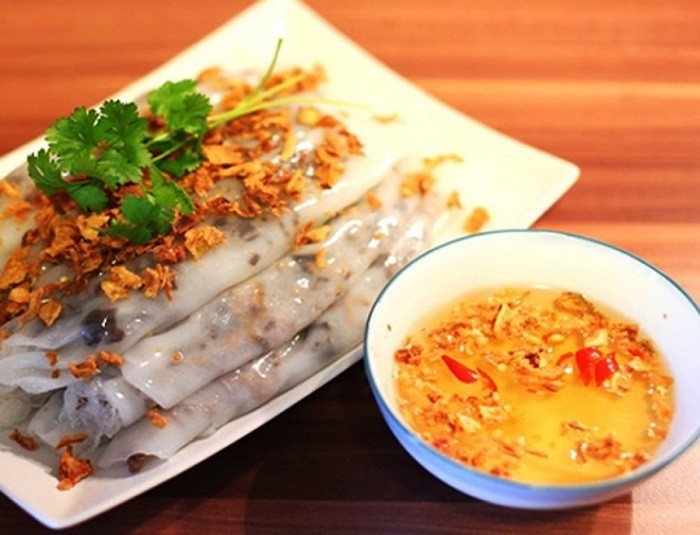 Phu Ly Roll Cake
Phu Ly Roll Cake
10.3. Quang Ninh Squid Rolls Cake
How is Quang Ninh Squid Rolls Cake prepared?
Similar to other places, Vietnamese steamed rice rolls in Quang Ninh still consist of a smooth, chewy crust made from rice flour rolled with minced pork and wood ear filling inside, dipped with fish sauce and sprinkled with fried onions on top. However, Quang Ninh has created a difference for steamed rice cake when using specialty squid rolls to accompany it. Grilled squid is made directly from fresh squid and pounded by hand, so it is crispy and fragrant. Combined with soft rolls will create an irresistible flavor. In addition, some places also add a bit of young shrimp to the filling to add more flavor to the rolls. This is a unique recipe in Vietnamese steamed rice rolls recipe.
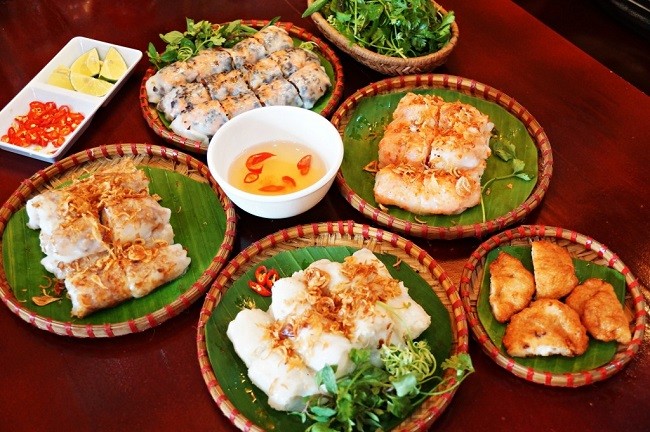 Quang Ninh Squid Rolls Cake
Quang Ninh Squid Rolls Cake
10.4. Egg Steamed Rice Cake (Lang Son)
What is the special ingredient in Lang Son Egg Steamed Rice Cake?
Lang Son egg roll cake only consists of chicken eggs and braised lean meat that are rubbed into small strands and broth is water that is simmered from the bone and added with spices, onions, coriander, pepper, and chili. Many shops in Lang Son also use braised gravy for a stronger taste. Chicken eggs are steamed inside the cake leaves, ripe enough to create a thin film around the yolk, preventing the eggs from breaking. These Vietnamese steamed rice rolls cannot be picked and dipped, but must be poured with broth on top of the cake. When enjoying, the user will skillfully put the piece of cake into the mouth so that the egg yolk breaks in the mouth, mixed with the braised gravy and the minced braised meat fibers are still hot and delicious.
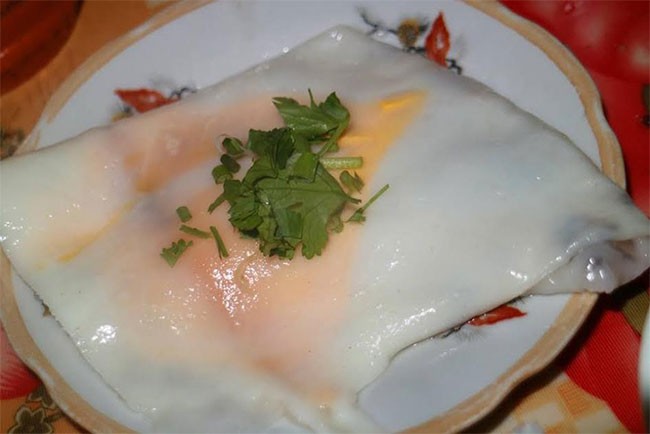 Egg Steamed Rice Cake
Egg Steamed Rice Cake
11. Traveling to Vietnam: Essential Tips
What should you know before traveling to Vietnam?
Traveling to Vietnam is an exciting experience, but it’s essential to be prepared. Here are some tips to help you plan your trip:
11.1. Visa Requirements
Do you need a visa to enter Vietnam?
Check the visa requirements for your nationality before traveling to Vietnam. Many countries are eligible for visa exemptions for short stays. According to the Vietnam Immigration Department, you can also apply for an e-visa online.
11.2. Currency and Payment Methods
What currency is used in Vietnam?
The official currency of Vietnam is the Vietnamese Dong (VND). While credit cards are accepted in major cities, it’s recommended to carry cash for smaller establishments and rural areas.
11.3. Transportation
How can you get around in Vietnam?
Vietnam offers various transportation options, including taxis, buses, trains, and domestic flights. In cities like Hanoi and Ho Chi Minh City, ride-hailing apps like Grab are popular and convenient.
11.4. Accommodation
What types of accommodation are available in Vietnam?
Vietnam offers a wide range of accommodation options, from budget-friendly hostels to luxury hotels. Popular booking platforms like Booking.com and Agoda provide numerous choices to suit your budget and preferences. With SIXT.VN, booking your perfect stay is a breeze.
12. Discover Vietnam with SIXT.VN
How can SIXT.VN enhance your travel experience in Vietnam?
SIXT.VN is your trusted partner for exploring Vietnam, offering a comprehensive range of travel services to ensure a seamless and unforgettable experience. We understand the challenges travelers face, from planning itineraries to navigating local transportation.
12.1. Tailored Tour Packages
How can SIXT.VN help you plan your trip?
SIXT.VN offers tailored tour packages to suit your interests and preferences. Whether you’re interested in exploring the cultural attractions of Hanoi, the scenic beauty of Ha Long Bay, or the culinary delights of Vietnam, we can create a customized itinerary for you.
12.2. Airport Transfers
How can SIXT.VN make your arrival and departure hassle-free?
SIXT.VN provides reliable and convenient airport transfer services to ensure a smooth arrival and departure. Our professional drivers will greet you at the airport and transport you to your hotel in comfort.
12.3. Hotel Booking
How can SIXT.VN help you find the perfect accommodation?
SIXT.VN offers a wide selection of hotels in Vietnam, ranging from budget-friendly options to luxury accommodations. We can help you find the perfect hotel to suit your needs and budget.
12.4. Sightseeing Tours
How can SIXT.VN help you explore Hanoi and beyond?
SIXT.VN organizes guided sightseeing tours to help you explore the top attractions in Hanoi and beyond. Our knowledgeable guides will provide insights into the history, culture, and cuisine of Vietnam.
12.5. Flight Booking
How can SIXT.VN help you find the best flight deals?
SIXT.VN can help you find the best flight deals to Vietnam. We partner with leading airlines to offer competitive prices and flexible booking options.
13. Address the Challenges
How does SIXT.VN address the challenges travelers face when visiting Vietnam?
- Detailed Itinerary Planning: SIXT.VN excels in crafting personalized travel itineraries that align perfectly with your interests and schedule, ensuring a trip that’s both fulfilling and time-efficient.
- Language and Cultural Navigation: With SIXT.VN, cultural and language barriers become a thing of the past; we provide comprehensive support to help you navigate and appreciate Vietnam’s rich heritage and customs.
- Reliable Travel Services: Addressing concerns about finding trustworthy travel services, SIXT.VN guarantees top-quality, reliable travel assistance, from airport pickups to hotel bookings.
- Seamless Transportation Solutions: Forget the stress of getting around; SIXT.VN offers smooth and dependable transportation services, enabling you to discover Hanoi and its surroundings with ease.
- Fast and Easy Booking Support: Understanding the need for speed and convenience, SIXT.VN delivers prompt assistance for booking hotels, flights, and tours, streamlining your travel preparations.
14. Additional Services and Information
What else does SIXT.VN provide to enhance your travel experience?
- 24/7 Customer Support: Our dedicated customer support team is available 24/7 to assist you with any queries or concerns.
- Local Insights: We provide valuable local insights to help you discover hidden gems and authentic experiences in Vietnam.
- Safety Tips: We offer safety tips and guidelines to ensure a safe and enjoyable trip.
15. Call to Action
Ready to experience the unique flavors of Banh Cuon in Hanoi and Cao Bang? Let SIXT.VN take care of all your travel needs. Explore our comprehensive tour packages, convenient airport transfer services, and wide selection of hotels.
Visit SIXT.VN today to start planning your dream vacation in Vietnam!
Address: 260 Cau Giay, Hanoi, Vietnam
Hotline/Whatsapp: +84 986 244 358
Website: SIXT.VN
16. FAQ About Banh Cuon and Vietnamese Travel
16.1. What is Banh Cuon made of?
Banh Cuon is made from a thin rice flour crepe filled with various ingredients, typically ground pork and wood ear mushrooms.
16.2. How does Cao Bang-style Banh Cuon differ from Hanoi-style?
Cao Bang-style Banh Cuon is served in a warm bone broth and filled with seasoned ground pork (no wood ear mushrooms), while Hanoi-style Banh Cuon is served with fish sauce and filled with ground pork and wood ear mushrooms.
16.3. Where can I find the best Banh Cuon in Hanoi?
You can find the best Banh Cuon in Hanoi at local street food stalls, markets, and specialty restaurants.
16.4. What are the visa requirements for traveling to Vietnam?
Visa requirements for traveling to Vietnam vary depending on your nationality. Check the latest regulations with the Vietnam Immigration Department.
16.5. What is the best way to get around in Vietnam?
The best way to get around in Vietnam is by taxi, bus, train, or domestic flight. In cities, ride-hailing apps like Grab are convenient.
16.6. How can SIXT.VN help me plan my trip to Vietnam?
SIXT.VN offers tailored tour packages, airport transfer services, hotel booking, sightseeing tours, and flight booking to ensure a seamless travel experience.
16.7. Is it safe to travel to Vietnam?
Yes, Vietnam is generally a safe country for tourists. However, it’s essential to take precautions against petty theft and scams.
16.8. What is the currency used in Vietnam?
The currency used in Vietnam is the Vietnamese Dong (VND).
16.9. What are some must-visit attractions in Hanoi?
Some must-visit attractions in Hanoi include Hoan Kiem Lake, the Old Quarter, the Temple of Literature, and the Ho Chi Minh Mausoleum.
16.10. Can I make Banh Cuon at home?
Yes, you can make Banh Cuon at home using rice flour, tapioca starch, ground pork, and other ingredients. Follow a recipe guide for best results.
By understanding the subtle yet significant differences in how Banh Cuon is prepared and enjoyed in Hanoi and Cao Bang, you’ll gain a deeper appreciation for Vietnam’s rich culinary landscape. Let SIXT.VN be your companion in exploring these flavors and many more, ensuring a journey filled with delightful discoveries and unforgettable experiences. With services tailored to meet your every need, from seamless airport transfers to handpicked hotel accommodations and expertly guided tours, SIXT.VN promises not just a trip, but an immersion into the heart of Vietnamese culture.
LSI Keywords: Vietnamese Cuisine, Hanoi Food Tour, Cao Bang Travel, Banh Cuon Recipe, Vietnam Travel Tips.

